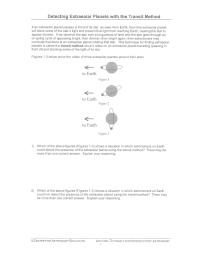
Developed by: Ed Prather, Tim Slater, Jeff Adams, and Gina Brissenden

middle schoolhigh schoolintro collegeinter-mediateupper levelgrad school other

conceptual





Overview
What? Socratic-dialogue driven, highly-structured collaborative learning activities for use in introductory Astronomy lecture courses. Designed to elicit students' misconceptions, confront their naive, incomplete, or inaccurate ideas, resolve contradictions, and demonstrate the power of conceptual models.
Activity outline
Students work through a lecture-tutorial worksheet in lecture after an interactive lecture on the topic covered in the lecture-tutorial. Each lecture-tutorial takes 10-20 minutes. While working on the lecture-tutorial, students should:
- Work with a partner.
- Read the instructions and the questions carefully.
- Discuss the concepts and your answers with each other.
- Come to a consensus on your answer before your group moves on to the next question.
- If you are stuck or not sure of your answer, check with a nearby group.
- If you are really stuck or don’t understand what the tutorial is asking, raise your hand and ask for help.
From: C.S. Wallace and E.E. Prather, Lecture-Tutorials in Introductory Astronomy, arXiv:1806.00452
Topic outline
The Night Sky
Position
Motion
Seasonal Stars
Solar vs. Sidereal Day
Ecliptic
Star Charts
Fundamentals of Astronomy
Kepler’s Second Law
Kepler’s Third Law
Newton’s Laws and Gravity
Apparent and Absolute Magnitudes of Stars
The Parsec
Parallax and Distance
Spectroscopic Parallax
Nature of Light in Astronomy
Electromagnetic (EM) Spectrum of Light
Telescopes and Earth’s Atmosphere
Luminosity, Temperature, and Size
Blackbody Radiation
Types of Spectra
Light and Atoms
Analyzing Spectra
Doppler Shift
Our Solar System
The Cause of Moon Phases
Predicting Moon Phases
Path of the Sun
Seasons
Observing Retrograde Motion
Earth’s Changing Surface
Greenhouse Effect
Temperature and Formation of Our Solar System
Sun Size
Stars, Galaxies, and Beyond
H-R Diagram
Star Formation and Lifetimes
Binary Stars
Motion of Extrasolar Planets
Stellar Evolution
Milky Way Scales
Galaxy Classification
Dark Matter
Looking at Distant Objects
Making Sense of the Universe and Expansion
Hubble's Law
Expansion of the Universe
Expansion, Lookback Times, and Distances
The Big Bang
Student skills developed
- Conceptual understanding
- Using multiple representations
Instructor effort required
- Low
Resources required
- Cost for students
Resources
Lecture-Tutorial: A Revised "How-To" Guide by Gina Brissenden & Edward Prather
What Are Lecture Tutorials published by SERC Pedagogy in Action
Teaching Materials
You can download some lecture-tutorials, and other teaching materials that go with them, for free from the Center for Astronomy Education website.
The full set of Lecture-Tutorials in Introductory Physics come in a book published by Pearson. You can order them from Pearson or from Amazon.
Research
This is the third highest level of research validation, corresponding to:
- at least 1 of the "based on" categories
- at least 1 of the "demonstrated to improve" categories
- at least 1 of the "studied using" categories
Research Validation Summary
Based on Research Into:
- theories of how students learn
- student ideas about specific topics
Demonstrated to Improve:
- conceptual understanding
- problem-solving skills
- lab skills
- beliefs and attitudes
- attendance
- retention of students
- success of underrepresented groups
- performance in subsequent classes
Studied using:
- cycle of research and redevelopment
- student interviews
- classroom observations
- analysis of written work
- research at multiple institutions
- research by multiple groups
- peer-reviewed publication
References
- J. Eckenrode, E. Prather, and C. Wallace, Research and Teaching: Correlations Between Students' Written Responses to Lecture-Tutorial Questions and Their Understandings of Key Astrophysics Concepts, J. Coll. Sci. Teaching 045 (03), (2016).
- E. Prather, A. Rudolph, G. Brissenden, and W. Schlingman, A national study assessing the teaching and learning of introductory astronomy. Part I. The effect of interactive instruction, Am. J. Phys. 77 (4), 320 (2009).
- E. Prather, T. Slater, J. Adams, J. Bailey, L. Monowar-Jones, and J. Dostal, Research on a Lecture-Tutorial Approach to Teaching Introductory Astronomy for Non–Science Majors, Astron. Educ. Rev. 3 (2), 122 (2004).
- A. Rudolph, E. Prather, G. Brissenden, D. Consiglio, and V. Gonzaga, A National Study Assessing the Teaching and Learning of Introductory Astronomy Part II: The Connection between Student Demographics and Learning, Astron. Educ. Rev. 9 (1), (2010).





